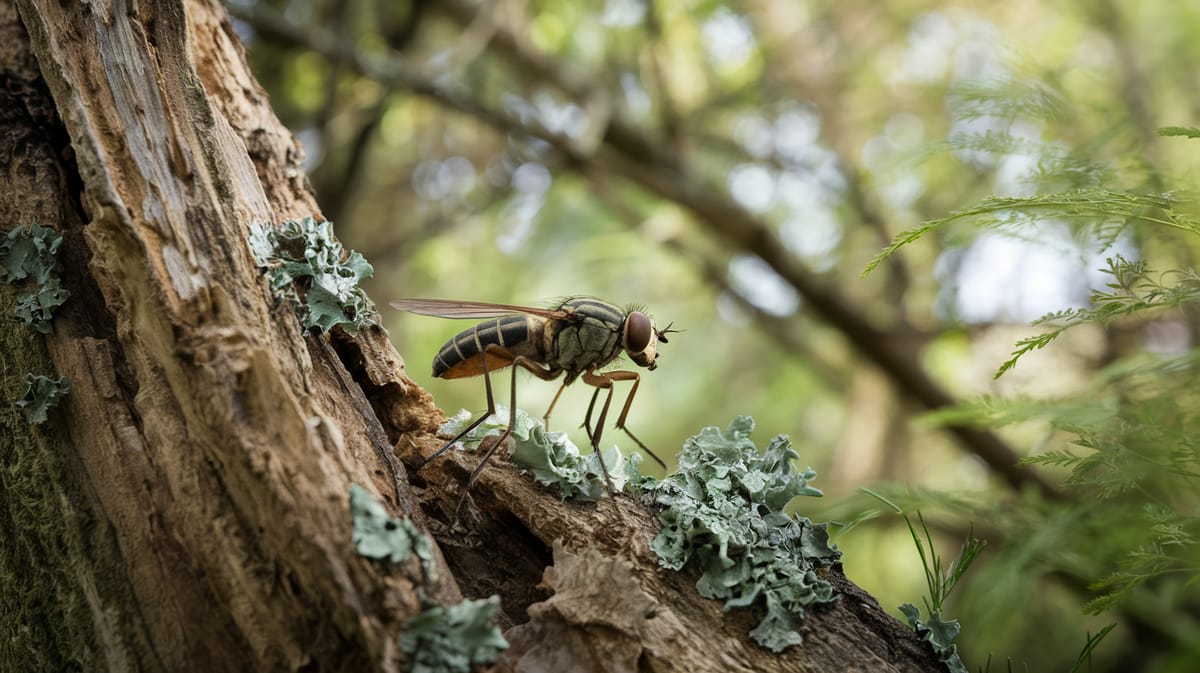Horse Fly
Horse flies, notorious for their painful bites, possess remarkable sensory abilities, allowing them to expertly track their prey. Their role as pollinators highlights their surprising ecological importance.

Key Insights at a Glance
Did You Know?
Taxonomy & Classification
Horse flies are notorious bloodsuckers with specialized mouthparts for piercing skin, playing a key role in transmitting diseases among animals. Let's understand the evolutionary journey and classification of these remarkable parasites.
Global Distribution
Horse flies, belonging to the genus Tabanus, are found on every continent except Antarctica, thriving in diverse climates and habitats.
Evolutionary Resilience
Dating back 65 million years, horse flies have evolved alongside mammals, adapting to exploit new hosts through various geological epochs.
Lifecycle and Growth
A remarkable journey of transformation from Egg to Adult.
Egg
Female horse flies lay clusters of eggs on vegetation near water, where they develop swiftly, relying on moisture for survival.
Larva
Larvae thrive in moist soil or aquatic environments, feeding on organic matter and small insects, crucial for their growth.
Pupa
Pupation occurs in dry soil, where larvae transform into adults, undergoing significant morphological changes.
Adult
Adults emerge with strong wings, engaging in feeding and reproduction; females are known for their blood-feeding behavior.
Dietary Habits
A blood-feeding insect with specialized mouthparts, this insect primarily targets mammals and occasionally feeds on amphibians and reptiles.
| DIET TYPE | DESCRIPTION |
|---|---|
| Primary Diet | Primarily feeds on the blood of mammals, using sharp mouthparts to pierce the skin and access blood vessels. |
| Secondary Diet | Consumes blood from birds when mammalian hosts are less accessible, showcasing its adaptable feeding strategy. |
| Occasional | Rarely feeds on amphibians and reptiles, typically during instances of scarcity of preferred hosts. |

Behaviour and Adaptations
Discover the fascinating traits that equip the Horse Fly for survival and success.
Blood-Feeding Efficiency
Skilled at locating and piercing animal skin for blood meals.
Flight Agility
Rapid and agile flight helps evade predators and capture hosts.
Sensory Acuity
Highly developed sensory organs detect heat and movement.
Ecosystem Impact
Horse Flies play crucial roles in maintaining ecological balance and sustainability.
Pollination Partners
Horse Flies aid in pollinating various plant species, helping sustain biodiversity.
Nutrient Recyclers
By feeding on animal waste, Horse Flies contribute to nutrient cycling in ecosystems.
Food Source
Serve as prey for birds, amphibians, and spiders, supporting diverse food webs.
Conservation Challenges
Understanding and addressing the major threats to Horse Fly populations.
Habitat Loss
Expanding urbanization reduces natural habitats for horse flies.
Pesticide Use
Chemical pesticides significantly impact horse fly survival and reproduction.
Climate Change
Altered weather patterns affect horse fly breeding and distribution.
Frequently Asked Questions
How long do Horse Fly live?
Horse flies typically live for about 30 to 60 days. Their lifecycle includes egg, larva, pupa, and adult stages. Environmental conditions and food availability can affect their lifespan. Adult horse flies are most active during warm months, especially in areas near water.
What do Horse Fly eat?
Female horse flies feed on blood from mammals to obtain protein for egg development. They often target livestock and humans. Male horse flies, however, primarily consume nectar and plant juices as they do not require blood for reproduction.
Are Horse Fly poisonous?
Horse flies are not poisonous. However, their bites can be painful and may cause allergic reactions in some individuals. They can also transmit diseases and parasites to livestock, which can lead to health issues. Their saliva contains anticoagulants, which assist in feeding.
Are Horse Fly endangered?
Horse flies are not considered endangered. They are widespread and found in various regions across the world. These insects thrive in environments with abundant water sources, as these areas provide ideal conditions for their breeding and larval development.
What do Horse Fly symbolize?
In various cultures, horse flies can symbolize persistence or annoyance due to their relentless nature. They may also represent the need for adaptation or awareness, as they are highly perceptive and able to react quickly to changes in their environment.
Do Horse Fly bite?
Yes, female horse flies bite, using their sharp mouthparts to cut the skin and feed on blood. Their bites are painful and can cause irritation or allergic reactions. Male horse flies do not bite, as they feed on nectar and plant juices instead.
What color are Horse Fly?
Horse flies typically have a dark, robust body, often black or brown. Some species may exhibit green or blue hues, especially on their eyes. Their wings can be clear or slightly clouded. Their coloration helps them blend into their surroundings.
Does a Horse Fly have wings?
Yes, horse flies have wings. These wings are strong and enable them to fly swiftly and with agility. Horse flies are known for their rapid flight, which helps them escape predators and locate hosts for feeding. Their wings are often clear or slightly patterned.
What does a Horse Fly look like?
Horse flies are large, robust insects with a length of 0.5 to 1.25 inches. They have prominent compound eyes, which are often iridescent. Their bodies are usually dark, and they possess strong, transparent wings. They are known for their persistent and aggressive behavior.
Is a Horse Fly an insect?
Yes, a horse fly is an insect. It belongs to the order Diptera, which includes true flies. Like other insects, horse flies have three main body parts: head, thorax, and abdomen. They possess six legs, compound eyes, and one pair of functional wings.
Related Insects
Discover insects with similar characteristics to Horse Fly - including shared habitats, diets, and taxonomic classifications
Share this profile
Help others discover Horse Fly
